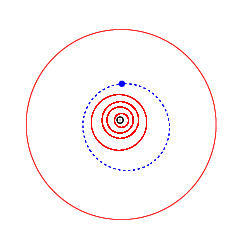9922 Catcheller
|
| |||||||||||||
| Discovery | |||||||||||||
|---|---|---|---|---|---|---|---|---|---|---|---|---|---|
| Discovered by | S. J. Bus | ||||||||||||
| Discovery date | 2 March 1981 | ||||||||||||
| Designations | |||||||||||||
| MPC designation | 9922 Catcheller | ||||||||||||
| 1981 EO21, 1977 DB6, 1979 SF8 | |||||||||||||
| Orbital characteristics[1] | |||||||||||||
| Epoch 13 January 2016 (JD 2457400.5) | |||||||||||||
| Uncertainty parameter 0 | |||||||||||||
| Observation arc | 13979 days (38.27 yr) | ||||||||||||
| Aphelion | 2.9104524 AU (435.39748 Gm) | ||||||||||||
| Perihelion | 1.8925570 AU (283.12250 Gm) | ||||||||||||
| 2.4015047 AU (359.25999 Gm) | |||||||||||||
| Eccentricity | 0.2119287 | ||||||||||||
| 3.72 yr (1359.3 d) | |||||||||||||
| 245.18444° | |||||||||||||
| 0° 15m 53.414s / day | |||||||||||||
| Inclination | 1.617217° | ||||||||||||
| 316.66036° | |||||||||||||
| 84.218619° | |||||||||||||
| Earth MOID | 0.900269 AU (134.6783 Gm) | ||||||||||||
| Jupiter MOID | 2.50963 AU (375.435 Gm) | ||||||||||||
| Jupiter Tisserand parameter | 3.494 | ||||||||||||
| Physical characteristics | |||||||||||||
| Dimensions | ~12.9 km[2] | ||||||||||||
| ~0.01 | |||||||||||||
| |||||||||||||
| 15.2 | |||||||||||||
|
| |||||||||||||
9922 Catcheller is a main belt asteroid. It orbits the Sun once every 3.72 years.[1] It is associated with the Nysa family of asteroids.[3]
Discovered on March 2, 1981 by Schelte Bus at the Siding Spring Observatory, it was given the provisional designation "1981 EO21". It was later renamed "Catcheller", a portmanteau of Joseph Heller and Catch-22, the novel he authored, on the suggestion of Brian Marsden.[4]
References
- 1 2 "9922 Catcheller (1981 EO21)". JPL Small-Body Database. NASA/Jet Propulsion Laboratory. Retrieved 13 April 2016.
- ↑ Tedesco E.F.; Noah P.V.; Noah M.; Price S.D. "The supplemental IRAS minor planet survey (SIMPS)".
- ↑ Zappalà, Vincenzo; Bendjoya, Philippe; Cellino, Alberto; Farinella, Paolo; Froeschlé, Claude (1997). "Asteroid Dynamical Families.". EAR-A-5-DDR-FAMILY-V4.1. NASA Planetary Data System.
- ↑ MPC 38199 Minor Planet Center
External links
This article is issued from Wikipedia - version of the 9/10/2016. The text is available under the Creative Commons Attribution/Share Alike but additional terms may apply for the media files.
